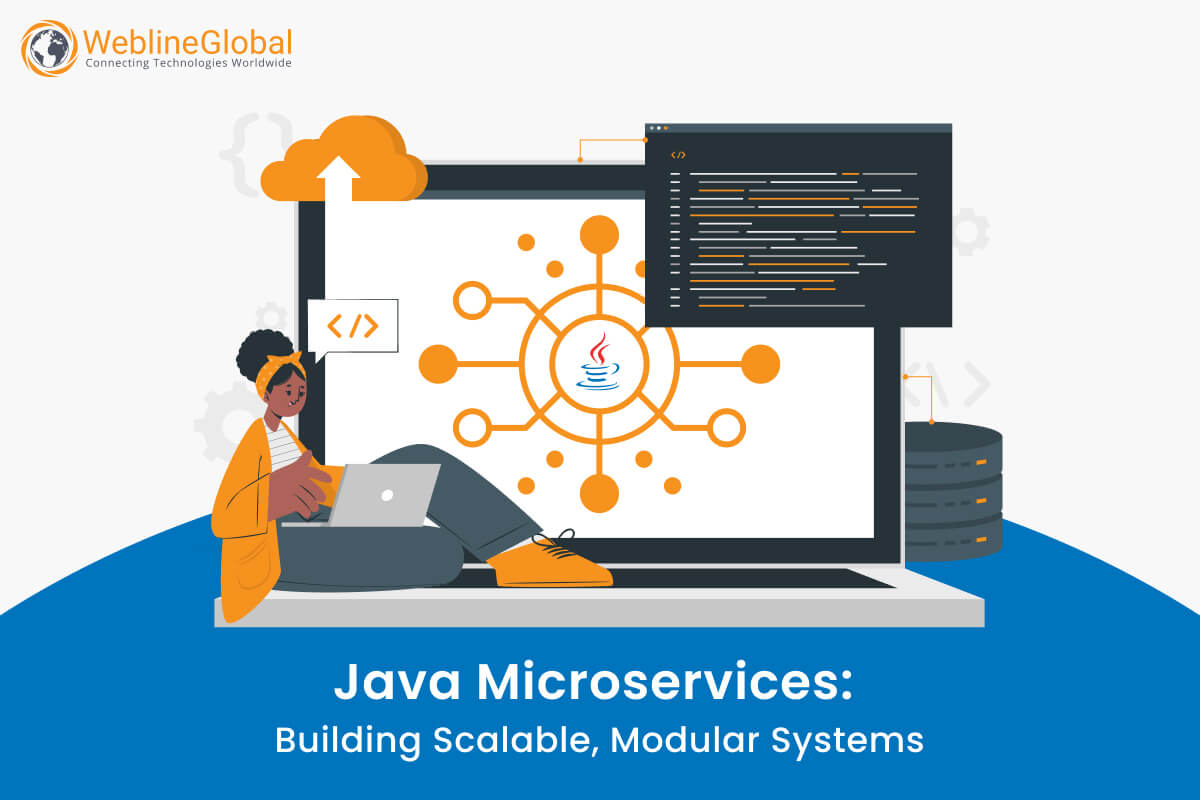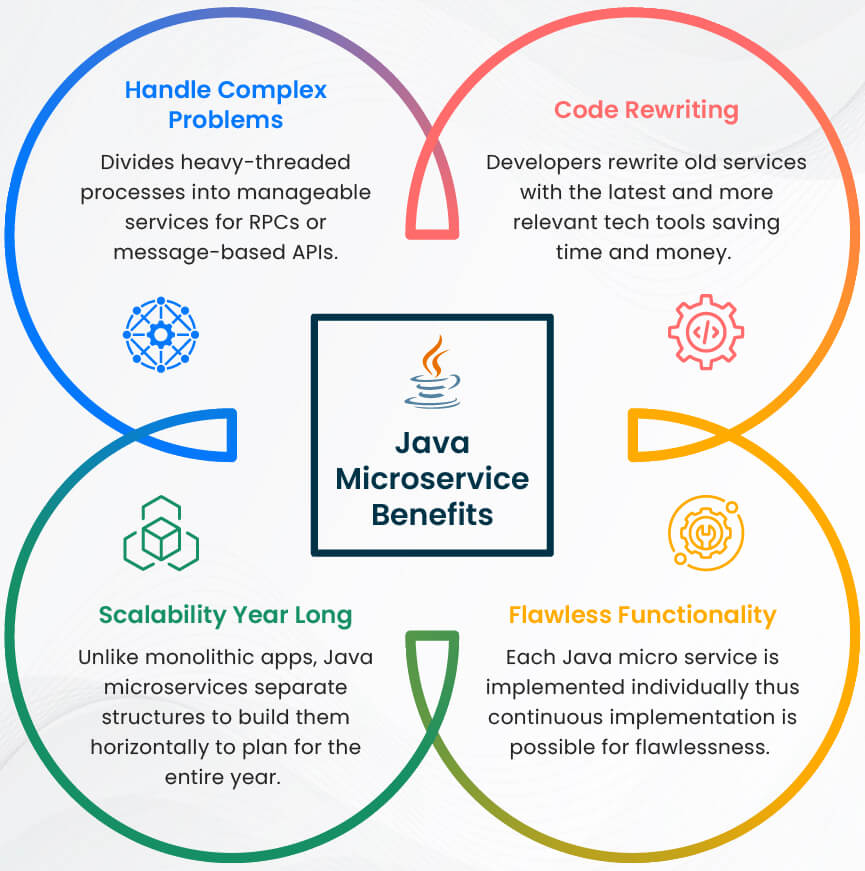
All modern-day enterprises have one thing in common – operational complexity. Large-sized enterprises have enormous amounts of data to deal with, and such data are sensitive and should be protected. When the business operations are complex, the software solutions built for them should be scalable and robust enough to handle innumerable requests and datasets with ease. Hence, what is Java Microservices? That’s the solution to the most complex business processes.
In this short guide, we will discuss microservices architecture in Java, spring boot-microservices architecture, its usage, and why you should go for Java microservices for your next scalable and modular system architect.
What is Java Microservices?
Microservices in Java are nothing but a software architecture method wherein a large app is decomposed into smaller ones. These smaller units are independent and can be built, deployed, and scaled separately.
Java and microservices, together, can do wonders to build complex scalable systems with ease because each unit or microservice here is allotted a separate responsibility to carry out a specific function or task or set of functions. They communicate with each other (microservices) using a well-structured interface and infrastructure, especially through LMP (lightweight messaging protocol).
Benefits of Microservices with Java to create scalable apps
When your enterprise deals with complex business operations and sensitive data to handle, you need to build enterprise mobility scalable systems that break down the complex processes into smaller ones that are easy to handle and operate. Java microservices offer a breakthrough solution to facilitate complex business architecture with manageable operations. Here are some of the noteworthy benefits of microservices with Java.

Java microservices frameworks
You must choose the right framework for the right Java microservices. You can hire Java microservices developers at WeblineGlobal to build apps suitable to your businesses at affordable costs yet compromise nothing on quality.
Here are some of the essential frameworks for microservices architecture in Java.
Spring Boot Microservices Architecture
Spring Boot is a basic Java-oriented framework to build microservices for any scalable systems. The framework supports dozens of unique concepts like aspect-oriented programming (AOP), addiction injections, and invert control. Microservices architecture with Spring Boot helps tremendously at a production level quickly and efficiently.
Javalin Microservices Architecture Framework
Written in Kotlin, Javalin supports both – Kotlin and Java without any compromise on performance. Javalin Java Microservice Framework is recommended if you want to build a reliable REST API because it is regularly updated (every few weeks) and thus stays the latest to cater to modern-day demands.
Spark Java Microservices Architecture Framework
Dating back to 2011, Spark is one of the oldest frameworks adopted by Java. It is a mini framework to create web apps in Java and Kotlin using minimum effort and code. Spark is tiny and completely focused on the outcome required.
Dropwizard Microservice Architecture Framework
Dropwizard is another Java-based architecture framework used to build apps that are easy to deploy and independent. They are high-performing and have interoperability features to sync with business logic easily.
How to Create Scalable and Modular Systems using Java Microservices?
Java microservices are useful for building complex scalable systems as they help programmers break down composite processes into simple and manageable flows. You need to follow some predefined steps to build scalable and modular systems using Java microservices architecture.
Monitoring is the gist of any sustained microservices architecture because the scaling of microservices banks on the number of incoming requests and handling them with ease without disturbing the operational flow.
Java microservices architecture can be used for independent scaling by including de-coupling to ensure simple alteration and fairly distributed API development. Also, it is essential to make sure that customization happens without creating any change in the component.
Java microservice forms
There are different forms of Java microservices that you can use to build scalable and modular systems. Unlike monolithic apps, Java microservices architecture possesses several features such as scalability, modularity, fault isolation, and seamless deployment and maintenance.
Different forms of Java microservices include:
Single service: It represents the smallest unit of microservice architecture. Here, a single service encapsulates particular functionalities or business capabilities for modular systems.
Composite: This type of microservice is made of multiple single-service microservices that work in sync to render top-level functionalities for modular systems.
Gateway: Such a type of microservice acts as an entry point for requests to handle tasks like routing, authentication, and load balancing.
Java Microservices best practices
One must follow the best practices to build Java microservices architecture for scalable systems and modular systems. Some of the industry-standard methods are adopted to ensure the best outputs.
Modularity and loose coupling
To get the best benefits of Java microservice architecture, you need to make sure that each Java-based microservice is a module coupled loosely with other services. Thus, you would have more flexible and maintainable web apps.
Proper error handling
Handling error and fault tolerance are quite important factors in maintaining the stability of Java-based microservices. You can implement circuit breakers, retries, and timeouts to avoid recurrent failures and ensure a smooth flow of app functions.
CI/CD
Continuous integration and continuous deployment (CI/CD) practices will help you automatize the development, testing, and deployment of Java-based microservices. As a result, you will have faster development with reduced human errors.
Vigilance
Assuring sharp monitoring and vigilance on Java-based microservices will help you get better insights and whereabouts. You may track resource usage, performance, and overall health for better outcomes.
Security
You need to follow industry-standard practices to prioritize security. You may opt for using HTTPS for communication and deploy a proper authentication mechanism to regularly keep an eye on vulnerabilities.
Documentation
Maintaining documents and checking for ambiguity is another essential factor in creating scalable and modular systems using Java microservices. API specification, data model, and architectural diagram can collaborate within teams to ensure smooth handover and transition of project developments.
Want to make your complex processes smoother?
Microservice architecture in Java can simplify your most complex processes into manageable tasks. Java software development services at WeblineGlobal can get you the best microservice architecture. We have a pool of Java developers who master the technologies and tools such as Spring Boot and Javalin to get you the end product with optimum performance.







